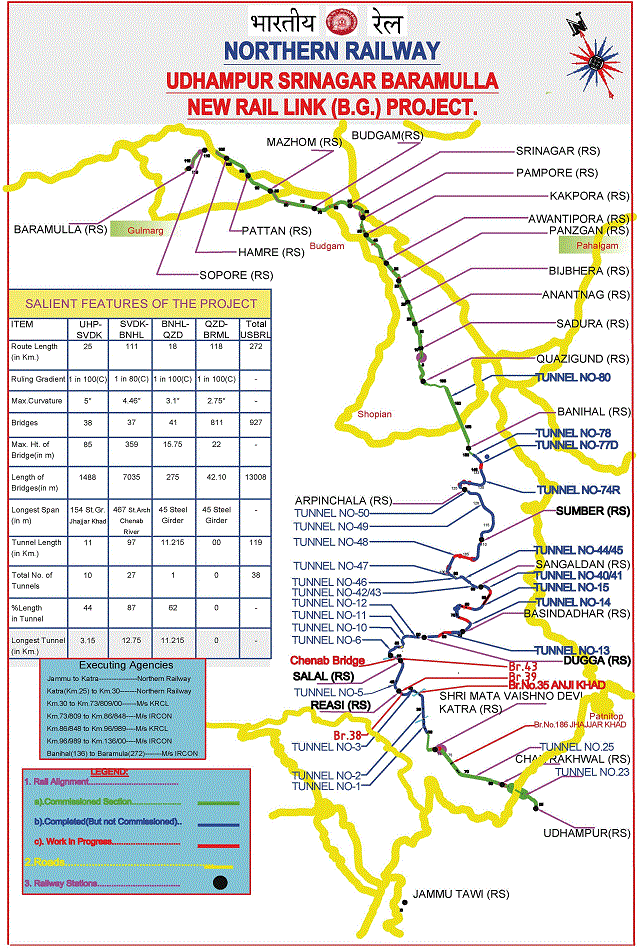According to top officials from Northern Railways, the Katra-Banihal rail line, which spans 111 kilometres, is almost finished with 95 per cent of the work completed.
The General Manager of Northern Railways, Shobhan Chaudhuri, inspected the ongoing work on the Katra-Banihal section of the Udhampur-Srinagar-Baramulla Railway Line (USBRL) project on Friday (7 July).
During his inspection in Jammu and Kashmir, Chaudhuri examined the project as well as other ongoing works. He was joined by S P Mahi, the Chief Administrative Officer of USBRL, Director R K Hegde, and other senior officials.
Mahi provided the team with an update on the progress of the project, stating that out of the total 272-kilometre stretch, 161 kilometres of railway tracks have already been commissioned.
Mahi further explained that despite numerous challenges including geological, topographical, and meteorological obstacles, the remaining 111-kilometre-long Katra-Banihal section is nearly complete, reports Economic Times.
This section is the most challenging portion for construction due to its geology and extensive riverine system with deep gorges.
USBRL Project
The 272-km-long railway line from Udhampur to Baramulla joining the Kashmir Valley with the Indian Railways network under the USBRL project was sanctioned in 1994-95.
One of the most challenging works undertaken post-independence by Indian Railways, the project aims to provide an alternative and reliable transportation system to Jammu and Kashmir.
In view of the importance of the USBRL project in providing seamless and hassle-free connectivity, it was declared a “National Project” in 2002.
The alignment of USBRL involves the construction of a large number of tunnels and bridges in highly rugged and mountainous terrain, with a difficult and complex young Himalayan geology.

Construction of the first three phases of the railway project has been completed and the line is operational between Banihal — Baramulla in Kashmir Valley and Jammu-Udhampur-Katra in Jammu region.
- The 118-km Qazigund-Baramulla section was commissioned in three phases between October 2008 and October 2009.
- The section from Banihal to Quazigund involving Pir Panjal Tunnel, the longest transportation tunnel in India of total 11.215 km length was opened to the public in June 2013.
- Similarly, the 25-km Udhampur-Katra section which is 25 km long was opened to the traffic in July 2014.
With 87 per cent of the total length (97 km out of 111 km) in tunnels, this section presents an engineering challenge in the highly rugged and mountainous terrain with one of the most difficult and complex Himalayan geology.
The Katra-Banihal line is expected to be operationalised by January 2024.
Significance
The Udhampur-Srinagar-Baramulla-Rail Link project is perhaps the most important and also the most challenging project taken up by the Indian Railways since Independence.
The strategic importance of the project to Jammu and Kashmir and to the nation as a whole cannot be overstated, and this has been recognised as such by no less than the former prime minister Atal Bihari Vajpayee, when he declared this to be a project of ‘National Importance’ in 2002.
This project is expected to bring about socio-economic development of Jammu and Kashmir through enhanced connectivity within the region and with rest of the country.
The project was envisaged to provide an efficient all-weather transportation channel that could function in adverse weather conditions and reduce the travel time to various destinations in and outside the valley considerably.
The project is very challenging, considering that the terrain is difficult and hostile, the weather conditions are tough, the security situation in the valley is sensitive and the logistics support is not really the best.
Also, this is the first time that the Indian Railways has taken up the construction of an entirely new line in an area which has not been mapped properly, does not have approach roads and where it would be difficult to transport the required construction material, tracks and other equipment.


